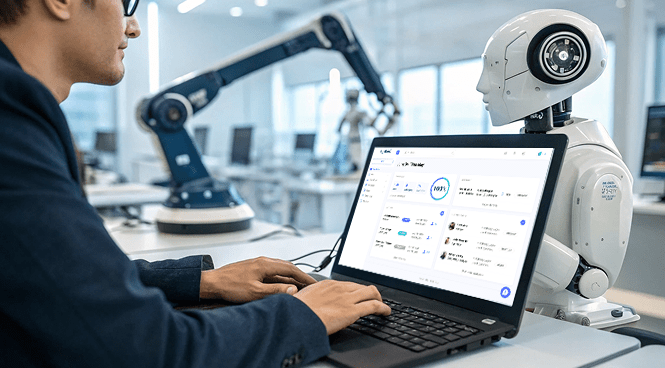If you’re in HR, you’ve likely felt the aftershocks of the Great Resignation. It hit historic highs in 2022, and though the pace has slowed slightly, the trend hasn’t reversed. Millions are still walking away from jobs every month, and it’s not always about the paycheck.
As workplace expectations shift, human resources teams need smarter, faster ways to listen, adapt, and act. That’s where artificial intelligence (AI) steps in.
AI isn’t a magic fix, but it can help you better understand your people and prevent top talent from slipping through the cracks. With the right tools, AI can give HR teams a fighting chance in reshaping work to meet modern demands, before your workers decide to leave.
Table of Contents
ToggleWhat Is Causing the Great Resignation?
While the term “Great Resignation” exploded during the pandemic, its roots go much deeper. Understanding the core drivers will help you target the right fixes.
Pandemic “Reevaluation”
The 2020 pandemic gave many the space to pause and reassess what they want from work. Remote working showed people a different kind of life, one that didn’t revolve around long commutes or rigid schedules. With quits rising to 50.6 million by 2022, for many, the realization has been simple: “I don’t want to go back to the old way.”
Burnout and Workload
Burnout rates soared as employees faced longer hours, increased workloads, and blurred boundaries between work and personal life. With burned‑out staff three times likelier to quit, overloaded roles remain a prime flight risk.
Lack of Career Growth
Stalled skill development ranks among the top predictors of turnover, especially for early‑career professionals who see rapid learning as non‑negotiable. It’s not enough to offer a job. People want to see a path forward. When career development is unclear or non-existent, employees are more likely to search for new roles elsewhere. Especially among younger workers, stagnation often triggers resignation.
Poor Management and Engagement
You’ve probably heard it before: people don’t quit jobs, they quit managers. In fact, 42% of preventable turnover can be tied to bad or absent management practices. Poor communication, inconsistent expectations, and a lack of recognition all erode employee trust and satisfaction.
Lack of Work‑Life Balance and Rewards
Many workers believe they were sacrificing too much for too little. When compensation, benefits, or time off don’t match the intensity of work demands, it creates a simmering frustration that often ends in a resignation letter. Even though overall job satisfaction hit a record high of 60% in 2022, large gaps persist around workload, pay transparency, and recognition – areas employees won’t compromise on anymore.
The High Cost of Attrition
Losing employees doesn’t just affect team morale; it significantly impacts your organization’s bottom line. Each resignation comes with recruiting costs, training expenses, and lost productivity. And with over 3.2 million quits per month so far in 2025, high turnover hasn’t just been inconvenient; it’s been expensive.

How Can AI Help Prevent the Great Resignation?
Now to the big question: what can you actually do about it? AI gives HR a new kind of toolbox. It doesn’t replace human insight, but it helps you make better, faster decisions based on data, not guesswork.
AI Can Improve the Employee Experience
AI tools, such as chatbots or virtual HR assistants, can streamline employee interactions by providing instant answers to common HR queries regarding leave, benefits, or procedures. This frees up HR teams to address more complex issues and provides employees with immediate support, which improves overall satisfaction.
AI Can Help Take Data-Driven Actions
You already collect mountains of employee data like feedback forms, performance reviews, and engagement surveys. But AI can help make sense of it all. It can highlight patterns in employee sentiment, flag declining morale, or identify departments with unusually high turnover. This data-driven decision-making allows you to act on what your employees are really saying, not just what they check in a box.
AI Can Provide Predictive Analytics
Wouldn’t it be helpful to know who’s likely to leave before they actually resign? AI analytics provide information on factors like declining engagement, lack of promotions, absenteeism, and even calendar patterns to spot early warning signs. You can then step in with support, whether it’s a career development talk or a burnout check-in.
AI Can Be Used to Transform Day-to-Day Experiences
Routine, repetitive tasks are often major sources of employee dissatisfaction. AI tools can automate these tasks, reducing boredom and frustration. For instance, automating administrative processes like scheduling, reporting, and data entry lets employees focus on more meaningful, rewarding activities.
AI Reduces Employee Workload
Automating repetitive tasks, such as expense coding, shift swaps, and basic report writing, does more than save time. It shows people you respect their capacity and helps prevent the burnout that fuels exits. In commercial businesses, for example, AI‑driven marketing tools cut content creation and data analysis hours significantly, leaving workers free to focus on more strategic tasks.
AI Can Provide Personalized Employee Training Programs
One-size-fits-all training is outdated. AI tools can create personalized learning paths based on an employee’s goals, current skills, and performance feedback. When people feel their development is being taken seriously, they’re more likely to stay and grow with the company.
AI Tools Can Help Support Employee Well-being
AI-driven wellness apps and platforms provide tailored wellness programs, mental health support, and self-care reminders. These tools encourage healthier lifestyles and better mental health, directly addressing employee burnout and promoting a balanced lifestyle.
Use AI for Lasting Engagement
Here’s the truth: fixing attrition isn’t a one-time project. It’s about building ongoing trust, listening consistently, and acting swiftly. AI helps you do that.
Leveraging AI strategically can create supportive, fulfilling workplaces, significantly reducing attrition. Improving day-to-day experiences, easing workloads, and proactively addressing employee needs equips your HR department to combat staff losses effectively.
Ultimately, using AI in HR isn’t just about efficiency; it’s about cultivating an environment where employees feel valued, supported, and genuinely engaged. With AI, your company can effectively tackle the root causes of the Great Resignation and foster long-term retention and sustainable growth.








